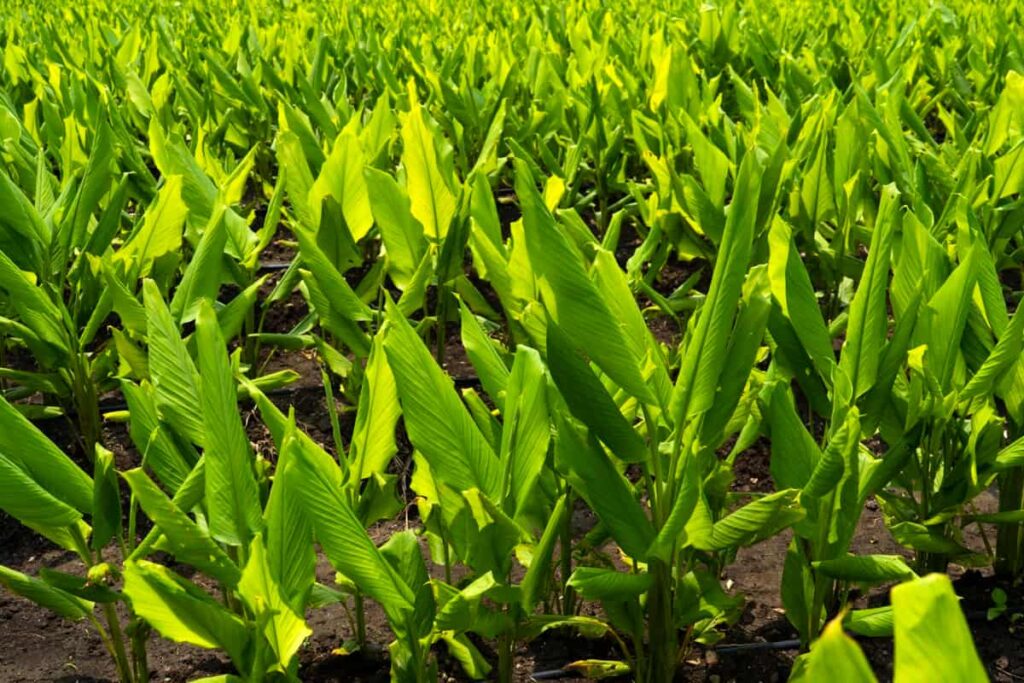Turmeric is also known as the golden spice of India. It has gained global consideration for its rich history, vibrant yellow colour, and diverse culinary and medicinal uses. Turmeric holds deep historical roots in ancient India, where it garnered immense cultural and religious significance. Ayurveda, the ancient Indian system of medicine, held turmeric in high regard for its remarkable anti-inflammatory, antioxidant, and antibacterial properties.
Turmeric’s utilisation in various medicinal formulations and rituals solidified its position as a revered ingredient in Indian culture. In this article, we will explore the cultivation of turmeric, its advantages, the difficulties farmers encounter, and many more.
Cultivation Process Of Turmeric Farming
- Climate and Soil– The ideal climate for turmeric farming is tropical and subtropical. Whereas the temperatures fall between 20°C and 30°C (68°F and 86°F). However, the soil requirement for turmeric cultivation is loamy, well-drained soil with sufficient organic matter for maximum growth. Keep it away from clay-rich or water-logged soils to prevent root rot.
- Selection of Rhizomes– Turmeric propagates through rhizomes. These are disease-free underground stems selected from trusted sources or harvested from previous harvests for planting.
- Preparation of Land– Land is ploughed, harrowed, and ridged before planting rhizomes, with organic matter or compost enhancing fertility. To prepare the land, you can choose Eicher 551 tractor, which gives efficient and reliable operations in turmeric farming. It also provides the necessary power and versatility to handle various tasks easily.
- Planting– Approximately 20 to 30 cm (8 to 12 inches) apart, turmeric rhizomes are sown. And prepared furrows at a depth of 5 to 7 cm (2 to 3 inches). The spacing enables effective weeding and irrigation and sufficient room for the plants to thrive.
- Irrigation– Regular watering is necessary for turmeric farming, especially in the early growth stages. Water stagnation should be avoided, as it might result in root rot.
- Mulching and Weed Management– Mulching with organic materials promotes soil moisture retention, weed growth inhibition, and temperature stabilisation. For optimal growth and to avoid weed competition, routine weeding is necessary.
- Harvesting– Turmeric is frequently ready for harvest in 7 to 9 months after sowing when the leaves begin to turn yellow and dry out. The rhizomes are carefully dug out, cleaned well, and left to dry in the sun for a few days until they become hard.
Health Benefits Of Turmeric
Turmeric has a compound called curcumin that gives numerous medical advantages. Its solid cell reinforcement and mitigating properties make it a well-known normal solution for different medical problems. A portion of the expected advantages of turmeric are:
- Reducing Inflammation– Curcumin assists in easing side effects of conditions with loving joint pain and provocative entrail sickness by diminishing irritation.
- Fighting Harmful Substances– Turmeric’s cell reinforcements can safeguard the body by killing unsafe substances called free extremists, which might lessen the gamble of constant infections.
- Boosting the Immune System– Turmeric can fortify the body’s guards against contaminations and infections, as it has resistant supporting impacts.
- Supporting Digestion System– Turmeric helps absorption, diminishes bulging, and advances a solid stomach.
- Improving Skin Health– Turmeric is utilised in skincare items to develop skin well-being further and diminish skin breakouts.
- Enhancing Culinary Experience – Besides its medical advantages, turmeric is a well-known zest in cooking, adding a splendid variety and a warm, gritty flavour to dishes.
Challenges in Turmeric Farming
Turmeric farming has its advantages, but it also comes with some challenges for farmers:
- Dealing with Disease and Pests
Turmeric is vulnerable to diseases and pests like rhizome rot, leaf spot, and nematodes. Farmers can reduce their impact by adopting Integrated Pest Management (IPM) practices.
- Maintaining Quality and Storage
It is essential to ensure consistent quality in turmeric production and use proper storage methods to avoid spoilage and preserve its value.
- Price Changes in the Market
The prices of turmeric can go up and down due to changes in demand and supply, affecting farmers’ income.
Opportunities for Sustainable Agriculture
1. Crop Diversity and Healthier Soil– Growing turmeric as part of crop rotation can improve soil health and reduce pests and diseases on the farm.
2. Organic Farming– The demand for organic turmeric is growing, allowing farmers to use eco-friendly methods and meet the needs of health-conscious consumers.
3. Adding Value to Products– Farmers can create various turmeric-based products like powder, extracts, and medicines, offering more opportunities for income.
4. Global Market– Turmeric’s popularity abroad opens up export opportunities, benefiting farmers financially and contributing to the country’s economy.
Conclusion
Turmeric farming offers an excellent chance for farmers to blend traditional knowledge with modern agricultural methods. Turmeric is a versatile plant used as a spice, medicinal herb, and a potential cash crop, making it an appealing choice for sustainable farming.
Farmers can benefit from cultivating turmeric by overcoming challenges and exploring market opportunities, enhancing their livelihoods. As consumers increasingly favour sustainable and natural options, the importance of turmeric in agriculture is expected to grow even further in the future. For successful turmeric farming, farmers can rely on the powerful and dependable Swaraj 742 tractor, which offers excellent performance and features tailored to meet the specific needs of this demanding agricultural practice.

